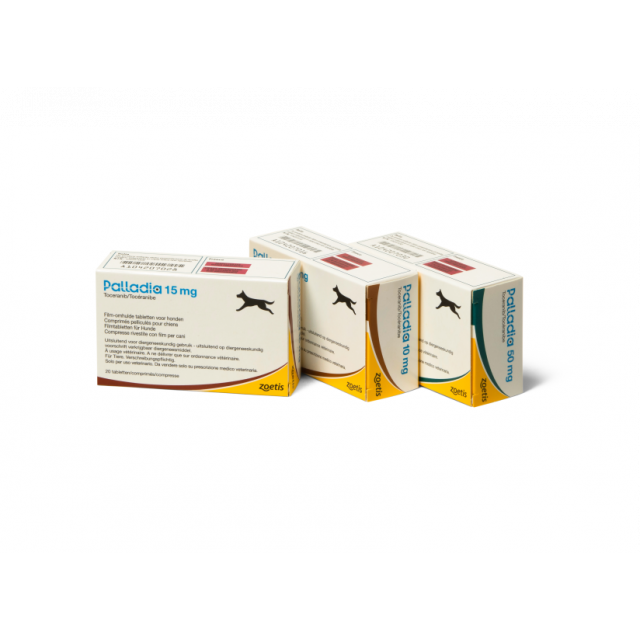Palladia
Palladia is used to treat a specific type of skin tumor in dogs when surgery is not an option (Patnaik grade II (intermediate grade) or III (high grade), recurrent mast cell tumors).
How Palladia Works
Palladia contains the active ingredient toceranib. It regulates the growth or division of certain cells. If a specific type of mast cell tumor cannot be completely removed, Palladia can be used.
Dosage of Palladia
Palladia is available in 10 mg, 15 mg, and 50 mg film-coated tablets.
The tablets can be given with or without food. The recommended starting dose is 3.25 mg of toceranib per kg of body weight, administered once every two days.
The dosage should be adjusted in close and regular consultation with your veterinarian.
Warnings for Use
Dogs receiving Palladia must be closely and regularly monitored by a veterinarian (weekly in the first weeks). The dosage may be adjusted, or administration may be paused in case of side effects.
Special precautions are also important for pet owners:
- Avoid skin contact with tablets, feces, urine, and vomit from treated dogs.
- Tablets must not be broken or crushed.
- If the dog spits out a chewed tablet, it should be discarded.
- Wash hands thoroughly with soap and water after administering the tablet or cleaning up vomit, urine, or feces from treated dogs.
- Pregnant women should not routinely administer Palladia and should avoid contact with vomit, urine, feces from treated dogs, and broken or moist Palladia tablets.
- Children must not come into contact with the medication. Keep children away from feces, urine, or vomit of treated dogs.
- Consult a doctor immediately if a tablet is accidentally ingested, and show them the leaflet or label.
Mast Cell Tumors
Mast cell tumors, also called mastocytomas, are the most common skin tumors in dogs. A mastocytoma can be relatively benign or highly malignant. A dog may have one or multiple mast cell tumors.
A mastocytoma often appears as a bald, reddish patch on the skin or a soft swelling in or on the skin that looks normal. However, a mastocytoma can vary greatly in appearance and may resemble a fatty lump. The tumor may grow quickly but can also shrink. Sometimes, a mastocytoma causes itchiness, which can lead to sores on the skin. Due to a substance secreted by a mast cell tumor (histamine, which also causes allergic reactions), a dog may experience vomiting, diarrhea, or even a sudden drop in blood pressure. Diagnosis is made by microscopic examination of a fine needle biopsy. The preferred treatment for a mastocytoma is surgery to remove the tumor with a wide margin. If this is not (completely) possible or if metastases are present, other treatments, including Palladia, may be recommended.
If you have any questions about Palladia or mast cell tumors in dogs, please contact us.



